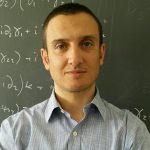
Biographical Information:
Massimo Meneghetti works at the Astronomical Osbervatory of Bologna, where he holds a researcher position. He is also a part-time Professor at the University of Bologna, where he teaches Gravitational Lensing to undergraduate students.Abstract:
Tensions on small scales: too many strong lenses in galaxy clusters?
In the standard cosmological model, the matter content of the Universe is dominated by cold dark matter (CDM), collisionless particles that interact with ordinary matter (baryons) only through gravity. Gravitationally bound dark-matter halos form hierarchically, with the most massive systems growing through mergers of smaller ones. As structure assembles in this fashion, large dark-matter halos contain smaller-scale substructures in the form of embedded subhalos.Observations of gravitational lensing can be used to map the inner mass distribution of cosmic structures such as galaxy clusters to test these predictions of the CDM paradigm.
Interestingly, the reconstructed granularity of cluster cores implies an excess of galaxy-galaxy strong lensing (GGSL) probability compared to expectations in the ΛCDM cosmological model. The theoretical estimates on the GGSL probability are based on the analysis of hydrodynamical simulations. At the same time, the observational measurements are derived from strong lensing reconstructions combining inputs from state-of-the-art HST and JWST imaging and MUSE/VLT spectroscopy. The most sophisticated galaxy cluster simulations have been analyzed to understand this issue. They implement numerical recipes to describe the interactions between baryons and dark matter. Physical processes involved in galaxy formation and evolution may be relevant to determining the cluster's ability to produce strong lensing effects. For example, the energy feedback from accreting black holes significantly impacts the properties of subhalos and their ability to produce GGSL effects. However, none of the hydrodynamical simulations studied so far agree with observations. They persistently have difficulty reproducing the stellar mass and the internal structure of cluster galaxies simultaneously. The mismatch may indicate an unidentified problem with prevailing simulation methods or standard cosmology.